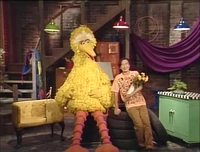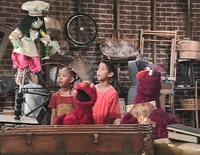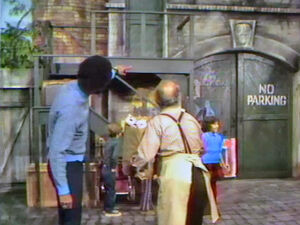
Gordon shows Mr. Hooper how the garage could use a fresh coat of paint in Episode 0138.
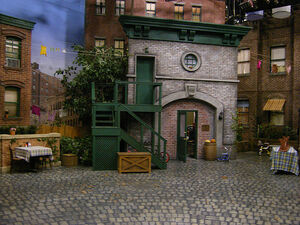
The carriage house in 2006.
- for the Henson-owned production facility, see The Carriage House
A carriage house is a structure originally built to accommodate a horse-drawn transport. While they typically no longer serve as such, the term continues to be used to describe such a building that has since been converted into some other kind of dwelling.
On Sesame Street, one such facility has been a staple on the show as positioned in the yard between 123 Sesame Street and Hooper's Store. When the geography of Sesame Street changed to a street corner in season 2, the yard widened enough to allow room for this structure in the back of the lot. Throughout the years, it has been used as a garage, an art studio, a veterinary office, and a community center.
When Gordon and Mr. Hooper fight over who owns the garage in Episode 0138, the script specifies that it used to be a literal carriage house for 123 Sesame Street. This plot in the episode ends with the two neighbors looking at the deed and determining that the building belongs half to the owner of Hooper's Store and half to the owner of 123 Sesame Street (Susan surmises that the original owner must have held the rights to all three properties before the split).
The term "carriage house" would be used in the modern sense in blueprints of the set, by Bill Cosby in the introduction of Sesame Street: 20 and Still Counting, and scripts in later years (such as episodes 3726 and 3797).
Garage[]
From 1970 to 2001, the building was used as a garage. Its exterior featured a large green staircase to a second floor attic (seen in Elmo's Magic Cookbook), as well as a basketball hoop. When not being used to house Susan's Volkswagen Beetle, it served as a multi-purpose storage space for the neighborhood, and was used prominently for a community garage sale in Episode 1436. Not long after in Episode 1749, a level of the building was taken up by Olivia to use as her photo studio.
Sometime prior to 1989, the garage fell under Oscar the Grouch's ownership and was used to house his Sloppy Jalopy. Hiroshi began renting out the space from Oscar in Episode 2537 to use as his art studio until his departure in 1990. In the early 1990s, Little Bird builds his nest in the front window of the building (as seen in Episode 2819).
In the 1975 book See No Evil, Hear No Evil, Smell No Evil, the garage was home to the Sesame Street Clubhouse. Members enjoyed the luxuries of a Super Grover pinball machine, a ping-pong table, piano, checkers set, record collection, and other recreational features.
Veterinary office[]
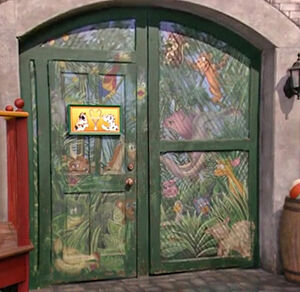
The doors of the veterinary office (seen here in Episode 4032) were covered with a colorful painted mural of a jungle.
In season 32, the building became home to Gina's new veterinarian practice. For season 33, the building was slightly redressed, with a new paint job for the stairs and double doors. These were reverted back by season 37, with the double doors replaced by a single door.
The main entrance to the office led to a waiting room where various animals (including chicken-kitten-cow-bunnies) would queue in preparation for their treatment by Gina. Past the reception area, Gina ran her practice, attending to many ailments.
In season 39, when production moved to a different studio within Kaufman Astoria Studios, the garage building was refitted and redressed. It no longer featured a staircase, a "Charlie's Auto Repair" sign was added (though this business was never seen in operation on the show), and the single door is replaced by windowed double doors (originally colored yellow and later changed to red in season 45).
Community center[]
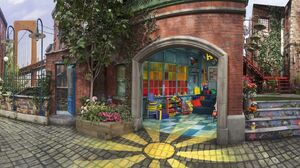
The community center in 2016.
During the set changes of season 46, the garage building was converted into a community center with games, toys and costumes. The rooftop was also revamped into a private sitting area.
In the 19th century scenes of Once Upon a Sesame Street Christmas, the community center was shown to be a fire station.
The center serves as the recording studio for The Sesame Street Podcast with Foley & Friends, and as the headquarters for the Power of We Club in their animated shorts.


